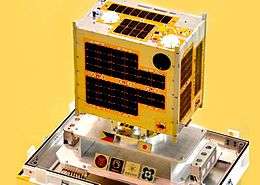Space program of the Philippines

The space program of the Philippines is decentralized and is maintained by various agencies of the Department of Science and Technology (DOST). There is no dedicated space agency to oversee the country's space program. Early Philippine initiatives in space technology has been led by private firms although in the recent years the government has played a more active role.
The Philippines has been involved in space technology since the 1960s, when the government built an Earth satellite receiving station by the administration of then-President Ferdinand Marcos. It was also during the latter part of this period that a Filipino private firm acquired the country's first satellite, Agila-1 which was launched as an Indonesian satellite. In the 1990s, Mabuhay had Agila 2 launched to space from China.
In the 2010s, the Philippine government partnered with the Tohoku and Hokkaido Universities of Japan to launch the first satellite designed by Filipinos, Diwata-1. Diwata-1 is a microsatellite. A centralized space agency has been proposed in the legislature to address funding and management issue faced by the country's space program.
Organization

The Philippines space program has two primary challenges; insufficient funding and the lack of a centralized agency to manage the space program.[1]
Several government agencies under the (DOST) currently maintains the country's space program are the Philippine Atmospheric, Geophysical and Astronomical Services Administration (PAGASA), the National Mapping and Resource Information Authority (NAMRIA), and the National Disaster Risk Reduction and Management Council (NDRRMC)[2][3][4] The DOST and the Manila Observatory crafted a 10-year masterplan in 2012 to make the Philippines a "space-capable country" by 2022.[5] A unified Philippine Space Agency (PhilSA) is also planned to be established according to the 17th Congress's "Philippine Space Act of 2016" (House Bill 3637)[6] and "Philippine Space Act" (Senate Bill 1211)[7].
History
Early initiatives
Efforts to establish a Philippine space program dates as early as in the 1960s, when US President Lyndon Johnson discussed with Philippine President Ferdinand Marcos in 1966 about the possibility of establishing a joint US–Philippine space program to monitor storms in Asia. If such plans have pushed through it would have been the first time Asians get involved in space activities.[8]
In the mid-1960s, the Philippine Communications Satellite (Philcomsat) was established when the Marcos government built an Earth satellite receiving station.[9] Philcomsat was a founding member of Intelsat, an international satellite consortium.[10] It also had an exclusive franchise for satellite communication in Southeast Asia, as well as in Korea and Japan. It was also responsible for providing the equipment which enabled people in Asia to watch the Apollo 11 launch, which took place in July 16, 1969.[11] The wholly government-owned company became a private corporation in 1982.[9]
PASI and Mabuhay's satellite ventures
.jpg)
In 1974, the Philippines planned to use satellites to improve communications. The leasing of satellites from Intelsat was considered but it was later decided to lease capacity from the Indonesian Palapa system. There were interests for a national communication satellite but initiatives to obtain one did not start until 1994, when the Philippine Agila Satellite Inc. (PASI), a consortium of 17 companies, was established to operate and purchase domestic satellites.[12] [13]
The Mabuhay Philippines Satellite Corporation (MPSC), another consortium, was formed in the same year by PLDT, which was a former member of PASI. PLDT was the largest member of PASI before its departure from the consortium. MPSC was composed of numerous domestic telecommunications and broadcasting companies, along with Indonesia-based Pasifik Satelit Nusantara and China-based Everbright Group.[13] [14]
Then, President Fidel V. Ramos expressed his desire for a Philippine satellite to be in orbit in time for the APEC Summit to be held in the country in November 1996.[13]
MPSC complied with the acquisition of Indonesian satellite Palapa B-2P from Pasifik Satelit Nusantara. The satellite was moved to a new orbital slot on August 1, 1996. The satellite was renamed Agila-1 and became the first satellite in orbit to be owned by the country.[15][16][17]
MPSC launched the country's second satellite, Agila-2, with assistance of China. The communications satellite was launched through the Long March 3B at the Xichang Satellite Launch Center on August 19, 1997. The satellite was acquired by Asia Broadcast Satellite in 2011[18] and was renamed to ABS-3.

Government initiatives in the 2010s
In the 2010s, the Philippine government got involved in space ventures. The DOST initiated the Philippine Scientific Earth Observation Microsatellite (PHL-Microsat) program to send two microsatellites in 2016 and 2017. The effort is part of the country’s disaster risk management program. A receiving station will also be built in the country.[19][20] The efforts were part of a bigger project, together with seven other Asian countries aside from Japan and the Philippines, to create a network of about 50 microsatellites.[21]
The first satellite under this program Diwata-1, the first satellite designed and assembled by Filipinos, with cooperation from the Hokkaido University and Tohoku University.[22] One of the major goals of the PHL-Microsat program is to boost the progress on the creation of the Philippine Space Agency.[23] The satellite was deployed from the International Space Station on April 27, 2016. The first nanosatellite, Maya-1 was also deployed from the ISS along with two other satellites on August 10, 2018.
President Rodrigo Duterte in February 2018 announced that a precursor to a space agency, the National Space Development Office, will be established. As of March 2018, there are seven pending bills in both the House of Representatives and the Senate seeking to establish the Philippine Space Agency (PhilSA).[1] In the meantime, the DOST has agreed with the Russian space agency Roscosmos, "to proceed with negotiations of an intergovernmental framework agreement on space cooperation that will include use of Russian rockets to launch Philippine payloads such as micro- and nano-satellites as well as the establishment of a receiving station for the Global Navigation Satellite System" (GLONASS), Russia's alternative to American Global Positioning System (GPS)[24]
Space education
The Department of Science and Technology–Science Education Institute (DOST-SEI) launched the first Philippine Space Science Education Program (PESSAP) in 2004, to promote science and technology, particularly space science, as a field of study to the Filipino youth.[25]
Student-researchers and science faculty from St. Cecilia's College - Cebu, Inc. in partnership with Department of Science and Technology-Philippine Council for Industry, Energy and Emerging Technology Research and Development (DOST-PCIEERD) successfully launched the first High-Altitude Balloon Life Support System "Karunungan" (HAB LSS Karunungan) in May 2018 at Minglanilla, Cebu, Philippines and floated above the Armstrong Line to simulate 'space like' conditions for future space flights.[26][27]
See also
References
- 1 2 de Guzman, Chad (23 March 2018). "PH takes small steps, as it aims for giant leaps in space technology". CNN Philippines. Retrieved 21 April 2018.
- ↑ Luces, Kim (October 15, 2013). "Reaching for the stars: Why the Philippines needs a space program". GMA News. Retrieved June 30, 2014.
- ↑ Cinco, Maricar (November 7, 2012). "Gov't space agency pushed". Philippine Daily Inquirer. Retrieved June 30, 2014.
- ↑ Pineda, Oscar (March 10, 2013). "Country needs to upgrade weather detection gear". Sun Star Cebu. Retrieved June 30, 2014.
- ↑ Usman, Edd (29 March 2015). "PH to become 'space-capable' in 10 yrs, according to DOST". Manila Bulletin. Retrieved 30 March 2015.
- ↑ {{cite url=http://congress.gov.ph/legisdocs/basic_17/HB03637.pdf|publisher=17th Philippine House of Representatives|accessdate=24 September 2018|date=15 September 2016}}
- ↑ {{cite url=https://senate.gov.ph/lis/bill_res.aspx?congress=17&q=SBN-1211|publisher=17th Philippine Senate|accessdate=24 September 2018|date=18 October 2016}}
- ↑ "Philippine chief lauds U.S. stand in Vietnam". St. Petersburg Times. 16 September 1966. Retrieved 13 May 2015.
- 1 2 "Wealth of Marcos recovered". Gadsden Times. Associated Press. 23 March 1986. Retrieved 18 January 2016.
- ↑ "Businessman urged gov't to set up satellite". Manila Standard. 12 December 1993. Retrieved 19 January 2016.
- ↑ "Space Age plant due in Dutchess". Wappingers Falls: The Evening News. 26 July 1969. Retrieved 18 January 2016.
- ↑ Martin, Donald (2000). "Asian African South American and Australian Satellites - Philippines". Communication Satellites (illustrated ed.). AIAA. p. 463. ISBN 1884989098. Retrieved 19 January 2016.
- 1 2 3 MacKie-Mason, Jeffrey; Waterman, David (26 November 2013). "Communication Satellite Policies in Asia". Telephony, the Internet, and the Media: Selected Papers From the 1997 Telecommunications Policy Research Conference. Routledge. pp. 239–242. ISBN 1136684263. Retrieved 19 January 2016.
- ↑ "PLDT Forms satellite firm". Manila Standard. 2 November 1994. Retrieved 19 January 2016.
- ↑ "Mabuhay acquires Indon satellite;sets new orbit". Manila Standard. July 25, 1996.
- ↑ "Mabuhay Acquires Pasifik Satellite". Telecompaper. August 6, 1996. Retrieved June 30, 2014.
- ↑ "Palapa B-2P". Weebau Space Encyclopedia. Retrieved June 30, 2014.
- ↑ "Agila 2 / ABS 5 → ABS 3". space.skyrocket.de. Retrieved 2018-01-25.
- ↑ De Guzman, RJ (June 24, 2014). "PH soon in space; DOST to launch satellite by 2016". Kicker Daily News. Retrieved June 30, 2014.
- ↑ Usman, Edd; Wakefield, Francis (June 30, 2014). "PH to launch own microsatellite in 2016". Manila Bulletin.
- ↑ "Asian Universities + Asian Nations Go Small... Monitor Natural Disasters w/Network Of Microsatellites". Satnews Daily. 13 January 2016. Retrieved 14 January 2016.
- ↑ Morimoto, Miki (6 March 2015). "Japanese, Filipino researchers to jointly develop satellites to check typhoon damage". Asahi Shimbun. Archived from the original on 10 March 2015. Retrieved 12 March 2015.
- ↑ Usman, Edd (15 January 2016). "DOST says PHL joining Asian 50-microsatellite alliance of 9 countries". Manila Bulletin. Archived from the original on 20 February 2016. Retrieved 15 January 2016.
- ↑ "DOST Finalizes MOU with Russian Space Agency". Department of Foreign Affairs (Philippines). 7 September 2018. Retrieved 24 September 2018.
- ↑ Salazar, Tessa (28 February 2015). "Pinoys engage in 'rocket science' that literally holds water". Philippine Daily Inquirer. Retrieved 15 November 2015.
- ↑ Usman, Edd (20 May 2018). "Cebu's young science geeks reach for the sky". Business Mirror. Retrieved 13 June 2018.
- ↑ Lacamiento, Grace Melanie (20 June 2018). "To go beyond limits". The Freeman. Retrieved 20 June 2018.